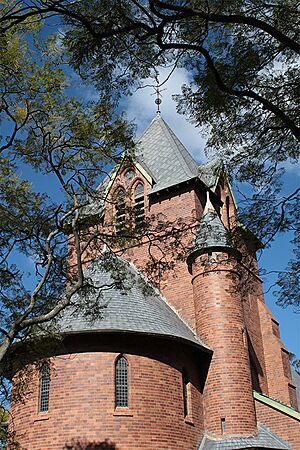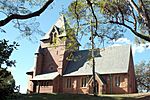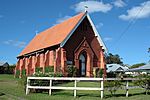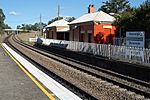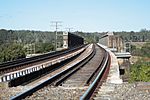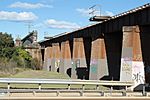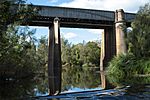Menangle, New South Wales facts for kids
Quick facts for kids MenangleNew South Wales |
|||||||||||||||
|---|---|---|---|---|---|---|---|---|---|---|---|---|---|---|---|
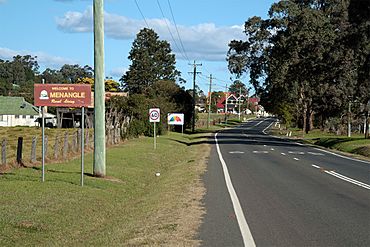
Entrance to Menangle village
|
|||||||||||||||
| Population | 1,150 (2016 census) | ||||||||||||||
| Postcode(s) | 2568 | ||||||||||||||
| Elevation | 86 m (282 ft) | ||||||||||||||
| Location |
|
||||||||||||||
| LGA(s) | Wollondilly Shire | ||||||||||||||
| Region | Macarthur | ||||||||||||||
| State electorate(s) | Wollondilly | ||||||||||||||
| Federal Division(s) | Hume | ||||||||||||||
|
|||||||||||||||
Menangle is a small village in the Macarthur region of New South Wales, Australia. It's a quiet place with a rich history and important landmarks.
Contents
Where is Menangle Located?
Menangle is part of the Wollondilly Shire area. In 2006, about 875 people lived here. By 2016, the population had grown to 1,150 people.
A Look Back: Menangle's History
The name "Menangle" comes from an Indigenous Australian word. It means 'a place of swamps and lagoons'.
In 1806, a man named Walter Davidson called his land "Manangle". This land later became part of the much larger Macarthur Estate. The village of Menangle grew to support the work of the Camden Park Estate.
When the railway opened in 1863, it changed things. Farmers could now send fresh milk to the Sydney Market overnight.
A special tramway was built to help construct the Sydney Harbour Bridge. It ran from the railway station to a sand-mining area near the Nepean River. This tramway is not used anymore.
Important Places: Heritage Listings
Menangle has several places that are protected because of their history. These are called heritage-listed sites. They include:
- The Menangle railway station on the Main Southern railway line.
- The amazing Nepean River railway bridge, Menangle on the Main Southern railway line.
Famous Faces from Menangle
Some well-known people have grown up or lived in Menangle:
- Albert Stephen Stanner was a church leader at St James Anglican church for many years. A stained glass window there remembers him.
- The Rubens is a popular Australian band. They were finalists in the Triple J Hottest 100 in 2012 and won in 2015. Three brothers and a childhood friend from Menangle make up the band.
- James Tedesco is the captain and fullback for the Sydney Roosters rugby league team. He grew up in Menangle.
- Jessica Cronje is a talented wheelchair basketball player.
The Menangle Railway Bridge: An Engineering Marvel
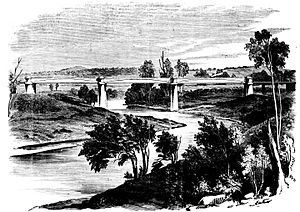
The Menangle Railway Bridge is the oldest railway bridge still standing in New South Wales. It was built under the guidance of John Whitton. This bridge carries the Main South Line over the Nepean River. It connects Menangle Park and Menangle.
When it opened in 1864, people were very impressed. It was the biggest engineering project on any railway in Australia at the time.
The bridge was first planned to have stone piers and iron beams. But after big floods in 1860, the design had to change. The river rose very high, so the bridge needed to be seven feet taller! The iron parts for the bridge were made in England and shipped to Australia. Even after one ship carrying parts sank, the loss was quickly replaced. The bridge was finished in just over six months.
The bridge has four large oval stone piers. These piers are very strong and were built using sandstone from a nearby quarry. The bridge deck is made of strong iron and wood. It stands 65 feet above the usual river level. The whole project cost about £80,000. Almost 1000 tons of iron and a lot of timber were used to build it. It was designed to be incredibly stable and strong.
In 2003, people were a bit worried about how strong the bridge was, but it continues to stand.
Menangle Village Today
The village has its own Menangle railway station. This station is on the main railway line that goes south.
Menangle is home to several historic buildings. These include Camden Park House, The Menangle Store, and the Rotolactor. Also, Gilbulla, The Pines, the Menangle railway station, and the Menangle Railway Viaduct are all heritage-listed.
There are two churches in Menangle: St James Anglican Church and St Patrick's Catholic Church. Both are also heritage-listed. St Patrick's is a good example of a simple country church from its time. St James Church is important because of its connections to the Macarthur-Onslow family and two famous architects, John Horbury Hunt and Sir John Sulman.
The old primary school in Menangle has been closed for over twenty years. It is waiting to be fixed up.
In the 1990s, more land was opened up for building homes. This caused the village's population to grow. Rules were made to protect the village's historic feel. Before 1992, water for the village was pumped from the Nepean River. But new developers provided a fresh water supply that year.
Menangle Gallery


